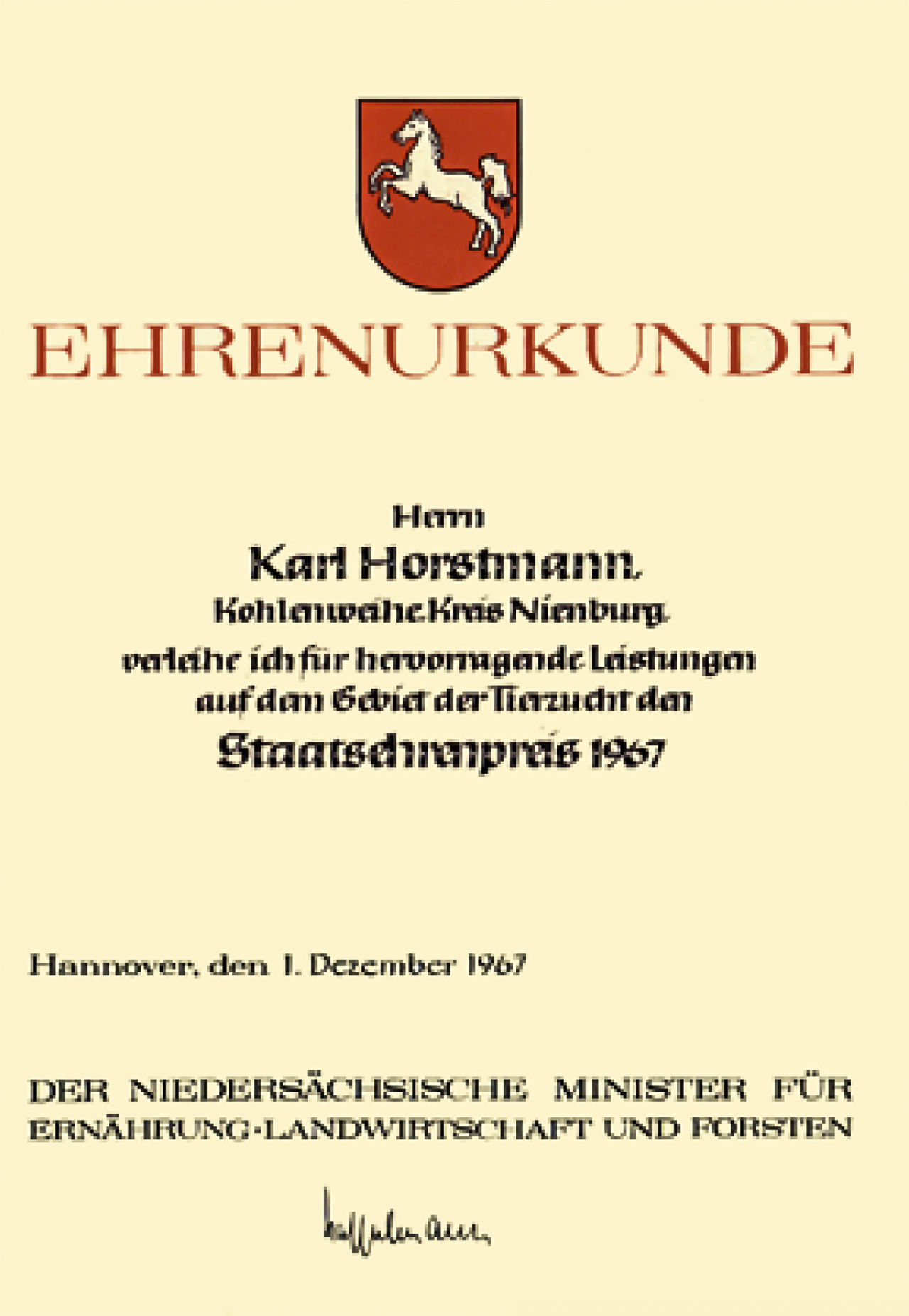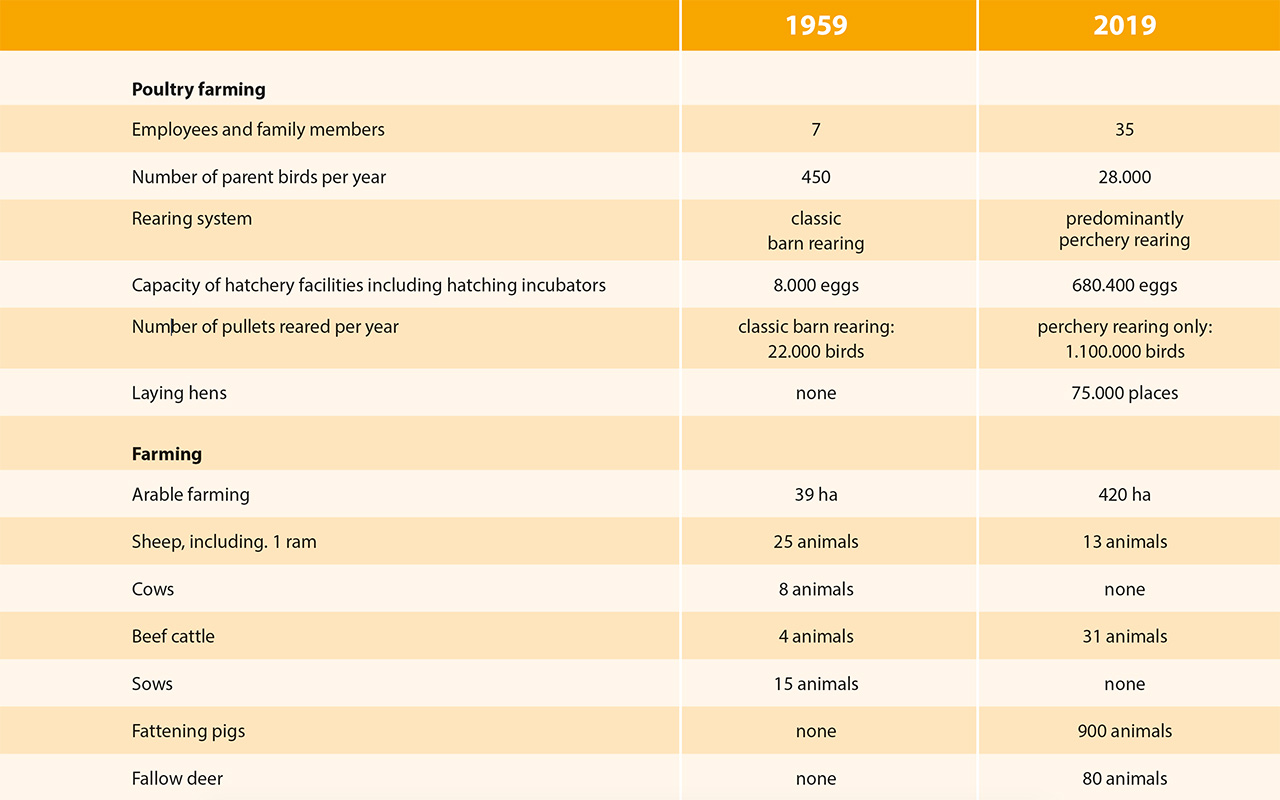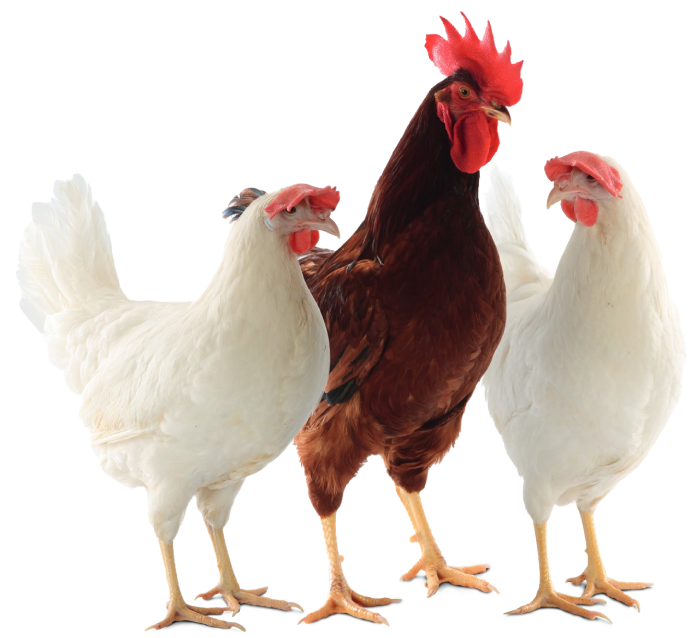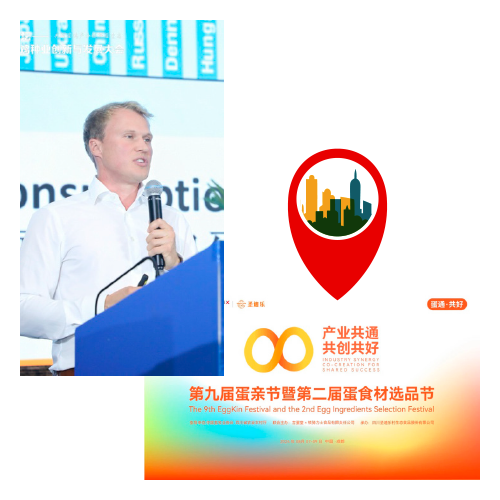The Horstmann poultry breeding firm started out simply as a farm. In 1935 Karl Horstmann Senior (born 24 October 1907) had already begun rearing and breeding laying hens on the farm. In 1949 the first hen house of any great size (stocked with 450 hens) was brought into operation. That was the real start of breeding and multiplication, which has now been constantly developed as the main sector of operations.
At some time around 1950 the business began breeding for the Breed Registry in cooperation with well-known hatching eggs suppliers (breeding stock). New Hampshire hens were bred for the Breed Registry. At the same time the farm bred Partridge-Coloured Italians and White Leghorns. From 1957 to 1959 the sons of the family, Karl and Dieter Horstmann, contributed to the German breeding project with New Hampshire and Leghorn breeds, the result of which was intended to be the German Master Hybrids.

Mr Heinz Lohmann introduced himself in 1958
In early 1958 the Hanover Chamber of Agriculture contacted Karl Horstmann junior (born 12 July 1936). There Mr Heinz Lohmann introduced himself in person in order to set up contact with what was then the largest hatchery in Lower Saxony. From their very first meeting Heinz Lohmann and Karl Horstmann saw eye to eye. It was quickly agreed that on a trial basis Karl Horstmann should obtain 200 hens as the end product of the HNL breed of laying hen (renamed LSL in 1978) directly from the USA.
The animals showed their mettle in Germany, with the result that the first HNL parent birds were purchased from the Horstmann breeding firm in 1959 by Heinz Lohmann. An appropriate breeding contract was concluded in the very same year. A group of hatcheries had formed themselves into a hybrid breed breeding association, with Mr Eckart Hosch as Managing Director. The object of the company was the placement of the breeding stock breeders’ excess (free) hatching eggs.

The HNL hens (today’s LSL) proved their worth:
In the years that followed the HNL laying hens secured themselves considerable shares of the market. The general trend towards larger production units, which was achieved through the technical development of the barn equipment (caged system housing) and the high standard of breeding of the pullets and laying hens promoted the fast growth of the Geflügelzucht Horstmann poultry farm.
In 1963 Dieter Horstmann (brother of Karl Horstmann junior) expanded the pullet breeding segment with their own barns to meet the demands of the steadily growing market.

State award
In 1967 in recognition of their success the Horstmann company was presented with the State Prize for Outstanding Services to Animal Breeding by the then Minister of Agriculture for Lower Saxony, Wilfried Hasselmann. Saved by the LTZ Veterinary Laboratory At the start of 1970 Geflügelzucht Horstmann was threatened with total shutdown. A disease, which is still with us today, Marek’s disease, was causing disastrous loss of animals. Frantically, the firm sought solutions from every possible direction.
Despair spread through the Horstmann family. However, they then they received a call from LOHMANN TIERZUCHT. There were reports that an innovative vaccine had been developed to control this devastating disease. As a last hope the vaccine was used by the LTZ Veterinary Laboratory in Horstmann’s ‘moor section’ hatchery.
The herpes virus, which had been isolated from turkeys, proved to have ground-breaking success as a vaccine and thus brought the desired salvation. At this point we would like once more to send our warm thanks to Dr. Egon Vielitz, the Head of the Veterinary Laboratory at that time.

A new LTZ product, the LB hens:
From about 1978 the white breeds began to lose market shares, since brown-shelled eggs were becoming increasingly popular, especially in North Germany.
LOHMANN TIERZUCHT responded to this trend. On the occasion of the LOHMANN Breeders’ Convention in November 1979 the new “LOHMANN BROWN” hen was presented.
Karl Horstmann junior took over this breed and together with the LSL began breeding the brown laying hybrids (LB). The LB hens also proved to be ‘highflyers’ both for their laying performance and for their low feed requirements.
With this product LOHMANN TIERZUCHT once more gained market shares, from which the LOHMANN breeders, including Geflügelzucht Horstmann reaped the benefits.
Breeding of LT hens for the alternative market:
In 1998 LOHMANN began breeding the LT parent birds in order to meet the increasing demand from the alternative sector. Geflügelzucht Horstmann reacted immediately and installed the first LOHMANN test flock on 6 March 1999. The first LT end products hatched on 30 July 1999.
The LT hens quickly became wellknown for their nest mobility and they were the hens “with the large eggs”. Current performance tests show that, compared with LB hens, the LT end product hen produces an egg weighing on average 2 grams more.
In addition, as regards total egg mass the LT hen with 22.2 kg lies only minimally below the LB hen (22.3 kg.). Over the course of the years this outstanding 20 years of breeding output has gained a substantial market share for Geflügelzucht Horstmann, especially in the self-marketing market segment because of the many large eggs (Class XL).

Status quo for Geflügelzucht Horstmann
In the last few years Geflügelzucht Horstmann has reared an average of approx. 28,000 parent birds per year. The perchery system has proved the preferred form of rearing. Pro rata approx. 15% LSL parent birds, approx. 40% LT parent birds and 45% LB parent birds are reared at the site at 31592 Stolzenau, Kohlenweihe 11.
Some 10% of the hatching eggs produced are sold to external customers and 90% are required for the firm’s own hatchery. The hatchery, which was newly built in 1977, has a potential capacity of approx. 3.5 million pullet chicks per year with maximum weekly production of 80,000 dayold chicks. Of the some 2.5 million chicks actually produced during the year approx. 55% are sold directly as day-old chicks and the other 45% are reared as pullets on the firm’s six breeding farms (perchery system).Since 1950 Geflügelzucht Horstmann has been recognised as a training company for animal farmers specialising in poultry. In March 2003 Frank, the son of Karl Horstmann and Knut, the son of Dieter Horstmann took over the management of Geflügelzucht Horstmann.
It is anticipated that in the fourth generation the brothers Nico, Kevin and Tom Horstmann will determine the further development of the Geflügelzucht Horstmann poultry business and will continue to rely on the breeding services of LOHMANN TIERZUCHT GmbH.

Rewards of experience:
One thing can be said about the previous generations and that is that during the last 60 years the Horstmann family have purchased the parent birds exclusively, because this firm has always supplied high quality birds.
During the last 60 years this quality has ensured success on the market vis-à-vis all the firm’s competitors. Another particularly important and valuable factor as regards this is that LOHMANN TIERZUCHT GmbH has reacted very quickly to altered market conditions and market requirements and has updated breeding policies in good time.
At this point the Horstmann family would like to congratulate LOHMANN TIERZUCHT GmbH on its 60th anniversary and thanks it for the cordial cooperation and the helpful support over the last 60 years.
Frank Horstmann & Family






